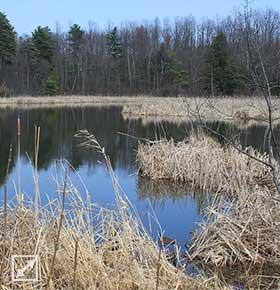Landscape Lenses
Ecological Landscape : Aquatic Communities
Today, all of the aquatic communities in Vermont are fresh water. These include rivers, streams, lakes and ponds. Bogs, fens, marshes and swamps are wetland communities that are shaped by both aquatic and terrestrial processes. 
Beaver pond and marsh in BurlingtonOne or more of the following processes will affect all aquatic and wetland communities to some degree: nutrient availability, water currents, freeze-thaw cycles, average water depth, water table fluctuations and flooding. Depending on how each of these processes shapes the community, different plants and animals will thrive in different aquatic environments. For example, emergent plants grow in calm, shallow water where there is adequate access to sunlight and protection from strong uprooting currents.
One important aspect of all water bodies in Vermont is that they are continually changing their shape and depth. Sedimentation and shifting hydrologic patterns result in lakes shrinking, rivers shifting, and marshes drying up. Because aquatic communities are so dynamic, they require large, specially protected areas to thrive over long periods of time. Many nutrients and pollutants are soluble in water, and are easily transported throughout the community. Aquatic communities are especially sensitive to changes in pH, and contamination by limiting plant nutrients such as nitrogen. The result is that the many plant and animal species that depend on Vermont’s aquatic and wetland communities for part or all of their lives are continually threatened by the loss and contamination and aquatic habitats. For example, the Restrictive Arm (the northeastern portion) of Lake Champlain regularly receives large quantities of agricultural run off.
The fertilizers and pesticides that work to make Vermont’s farms productive on land can act as deadly pollutants in the water. This tension between land use and protection of waterways plays out constantly along the Burlington Waterfront. The result of fertilizers leaching into the water is an overgrowth of algae and bacteria that consume large amounts of dissolved oxygen in the water as they reproduce, leading to the death of many other aquatic plants and animals. In general, aquatic communities are more sensitive to, and take longer to recover from pollution than do terrestrial environments.